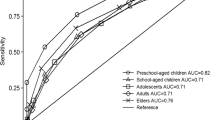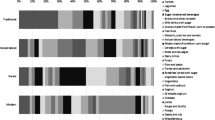Abstract
Objectives:
Adequacy of dietary intake in the sensitive period of toddler development is a key determinant of health in a short- and long-term perspective. Therefore, studies focussing the nutrition of toddlers are of importance. For this purpose, tailored dietary record methods are an important prerequisite. The objective of this work is to develop a toddler-specific estimated food record (EFR) in a booklet providing photographs of age-specific foods and portion sizes that should be accurate and simple.
Subjects/Methods:
For a toddler study in Germany, a 7-day consecutive EFR was developed. Data were obtained from a sample of toddlers in Germany. The basis is an evaluation of 3-day weighing food records on food choice and portion size of the DONALD (Dortmund Nutritional and Anthropometric Longitudinally Designed) study for 227 toddlers (118 boys) aged 9–36 months from January 2004 to March 2008.
Results:
In the analysed food records, a total of 15.147 eating occasions with 24.820 dishes were reported and grouped in 17 food groups. To estimate the portion size, the median consumption amounts of the 194 most frequently consumed dishes were calculated and photographed. Formula and commercial complementary food are collected separately. EFR was structured into seven eating occasions of the day: before breakfast, breakfast, mid-morning, lunch, mid-afternoon, dinner, and before bed.
Conclusions:
The EFR booklet provides a simple, feasible and validated instrument that can be used to update information on dietary habits during the transition from infant to childhood diet for families in different social classes.
This is a preview of subscription content, access via your institution
Access options
Subscribe to this journal
Receive 12 print issues and online access
$259.00 per year
only $21.58 per issue
Buy this article
- Purchase on Springer Link
- Instant access to full article PDF
Prices may be subject to local taxes which are calculated during checkout


Similar content being viewed by others
References
Pediatrics AAP. Pediatric Nutrition Handbook. American Academy of Pediatrics: Elk Grove Village, IL, USA, 2009.
Hanley B, Dijane J, Fewtrell M, Grynberg A, Hummel S, Junien C et al. Metabolic imprinting, programming and epigenetics—a review of present priorities and future opportunities. Br J Nutr 2010; 104: S1–25.
Cooke L . The importance of exposure for healthy eating in childhood: a review. J Hum Nutr Diet 2007; 20: 294–301.
Buyken AE, Alexy U, Kersting M, Remer T . [The DONALD cohort. An updated overview on 25 years of research based on the Dortmund Nutritional and Anthropometric Longitudinally Designed study]. Bundesgesundheitsblatt Gesundheitsforschung Gesundheitsschutz 2012; 55: 875–884.
Kroke A, Manz F, Kersting M, Remer T, Sichert-Hellert W, Alexy U et al. The DONALD Study. History, current status and future perspectives. Eur J Nutr 2004; 43: 45–54.
Sichert-Hellert W, Kersting M, Chahda C, Schäfer R, Kroke A . German food composition database for dietary evaluations in children and adolescents. J Food Comp Analysis 2007; 20: 63–70.
Schoen S, Sichert-Hellert W, Kersting M . Validation of energy requirement equations for estimation of breast milk consumption in infants. Public Health Nutr 2009; 12: 2309–2316.
Cheng G, Hilbig A, Drossard C, Alexy U, Kersting M . Relative validity of a 3 d estimated food record in German toddlers. Public Health Nutr 2012; 16: 645–652.
Briefel RR, Kalb LM, Condon E, Derning DM, Clusen NA, Fox MK et al. The Feeding Infants and Toddlers Study 2008: study design and methods. J Am Diet Assoc 2010; 110: S16–S26.
Ponza M, Devaney B, Ziegler P, Reidy K, Squatrito C . Nutrient intakes and food choices of infants and toddlers participating in WIC. J Am Diet Assoc 2004; 104: s71–s79.
Ziegler P, Briefel R, Clusen N, Devaney B . Feeding Infants and Toddlers Study (FITS): development of the FITS survey in comparison to other dietary survey methods. J Am Diet Assoc 2006; 106: S12–S27.
Freeman V, van't Hof M, Haschke F . Patterns of milk and food intake in infants from birth to age 36 months: the Euro-growth study. J Pediatr Gastroenterol Nutr 2000; 31: S76–S85.
Kattelmann KK, Ho M, Specker BL . Effect of timing of introduction of complementary foods on iron and zinc status of formula fed infants at 12, 24, and 36 months of age. J Am Diet Assoc 2001; 101: 443–447.
Greco L, Musmarra F, Franzese C, Auricchio S . Early childhood feeding practices in southern Italy: is the Mediterranean diet becoming obsolete? Study of 450 children aged 6-32 months in Campania, Italy. Cultural Paediatric Association. Acta Paediatr 1998; 87: 250–256.
Rasanen L, Ylonen K . Food consumption and nutrient intake of one- to two-year-old Finnish children. Acta Paediatr 1992; 81: 7–11.
Fisher JO, Butte NF, Mendoza PM, Wilson TA, Hodges EA, Reidy KC et al. Overestimation of infant and toddler energy intake by 24-h recall compared with weighed food records. Am J Clin Nutr 2008; 88: 407–415.
Ovaskainen ML, Paturi M, Reinivuo H, Hannila ML, Sinkko H, Lehtisalo J et al. Accuracy in the estimation of food servings against the portions in food photographs. Eur J Clin Nutr 2008; 62: 674–681.
Hilbig A, Alexy U, Drossard C, Kersting M . GRETA: Ernährung von Kleinkindern in Deutschland. Aktuel Ernährungsmed 2011; 36: 224–231.
Statistisches Bundesamt Informationsgesellschaft in Deutschland 2009. www.destatis.de (accessed on 10 May 2013).
Nicklas TA, O'Neil CE, Stuff J, Goodell LS, Liu Y, Martin CK . Validity and feasibility of a digital diet estimation method for use with preschool children: a pilot study. J Nutr Educ Behav 2012; 44: 618–623.
Fox MK, Pac S, Devaney B, Jankowski L . Feeding Infants and Toddler Study: what foods are infants and toddlers eating? J Am Diet Assoc 2004; 104 (Suppl): S22–S30.
Acknowledgements
The participation of all families in the study is gratefully acknowledged. We also thank the staff of the TNS Healthcare GmbH Munich for carefully collecting the dietary and other information of the study participants and Nestlé Nutrition GmbH Germany for financial support.
DISCLAIMER
The interpretation and reporting of these data are the sole responsibility of the authors.
Author information
Authors and Affiliations
Corresponding author
Ethics declarations
Competing interests
The authors declare no conflict of interest.
Rights and permissions
About this article
Cite this article
Hilbig, A., Drossard, C., Kersting, M. et al. Development of an estimated food record for 9–36-month-old toddlers. Eur J Clin Nutr 68, 907–915 (2014). https://doi.org/10.1038/ejcn.2014.52
Received:
Revised:
Accepted:
Published:
Issue Date:
DOI: https://doi.org/10.1038/ejcn.2014.52
This article is cited by
-
Are Belgian toddlers over-eating?
European Journal of Nutrition (2017)



